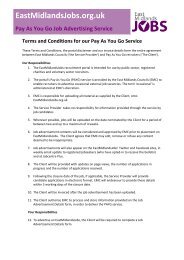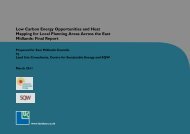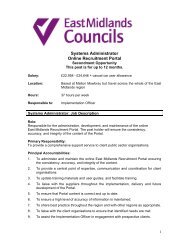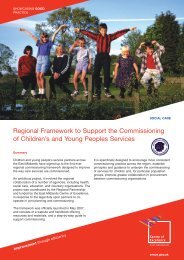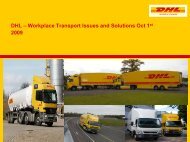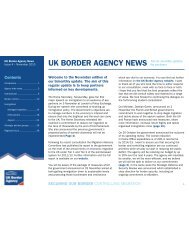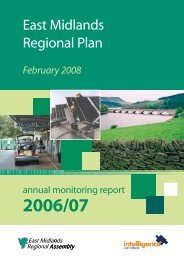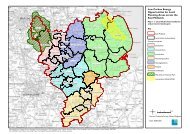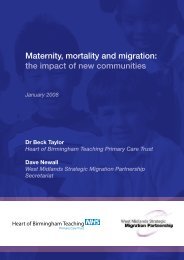East Midlands Regional Spatial Strategy 2005/06
East Midlands Regional Spatial Strategy 2005/06
East Midlands Regional Spatial Strategy 2005/06
You also want an ePaper? Increase the reach of your titles
YUMPU automatically turns print PDFs into web optimized ePapers that Google loves.
<strong>East</strong> <strong>Midlands</strong> <strong>Regional</strong> <strong>Spatial</strong> <strong>Strategy</strong> Annual Monitoring Report <strong>2005</strong>/<strong>06</strong><br />
Data Analysis<br />
7.8 The <strong>East</strong> <strong>Midlands</strong>, along with the South West,<br />
had the highest growth in traffic with an increase of<br />
21% on major roads between 1995 and <strong>2005</strong>. The<br />
number of vehicle kilometres travelled in the <strong>East</strong><br />
<strong>Midlands</strong> in <strong>2005</strong> was 40,633 million compared to<br />
38,075 million in 2001. The <strong>2005</strong> figure represents a<br />
slight decrease on the 2004 figure of 40,654 million<br />
kilometres. The distribution across different types of<br />
road is shown in Table 7.1<br />
7.9 Although now classified as a significant effects<br />
indicator, there are still difficulties in measuring<br />
congestion, in particular identifying some average<br />
congestion figure for the <strong>East</strong> <strong>Midlands</strong> as a whole.<br />
Congestion is by its nature localised either in urban<br />
areas, or more particularly on roads in urban areas, or<br />
on major roads. While it is desirable and feasible to<br />
establish that congestion occurs on particular routes<br />
and at particular times this tends to be a local issue<br />
(covered in local transport plans) and is either due to<br />
volume of traffic, a pinch point, road works or an<br />
accident.<br />
7.10 A measure of congestion that has been used is<br />
average journey time per person mile related to the<br />
change in travel expressed in person miles.<br />
Nottingham City and Leicester City, along with other<br />
large English conurbations, have contributed to the<br />
formulation of this indicator for urban congestion<br />
(LTP7). However the indicator will be surrounded by<br />
a basket of other indicators as background<br />
information, such as area wide network speeds,<br />
occupancy or bus mode share on the targeted<br />
routes, area wide traffic (LTP2) and changes in peak<br />
period traffic flows to the City Centre (LTP6).The DfT<br />
has commissioned ITIS to help survey flows of traffic.<br />
7.11 In the 2004/05 monitoring report a comparison<br />
was made of the traffic speeds at peak and off peak<br />
periods (the expectation being that peak periods<br />
have increased traffic flow and hence greater<br />
possibilities of congestion). There was little<br />
difference in the speed of traffic on <strong>East</strong> Midland’s<br />
trunk roads between peak and off peak periods.<br />
Policy Commentary<br />
7.12 As part of the work to accommodate the Milton<br />
Keynes & South <strong>Midlands</strong> (MKSM) growth agenda,<br />
Northamptonshire County Council and the Highways<br />
Agency have been working with North Northants<br />
Development Company, Communities and Local<br />
Government and DfT to come up with innovative<br />
measures to remove local traffic from the A14 around<br />
Kettering.This includes proposals for challenging<br />
levels of modal shift and demand management.<br />
7.13 The local authorities in and around the Three<br />
Cities sub area (Nottingham, Leicester and Derby)<br />
have been allocated £1.8 million for an in-depth<br />
investigation of the possible options for tackling<br />
traffic problems and improving roads and public<br />
transport.The funds will be used to consider the<br />
potential for possible road pricing schemes and<br />
other transport options to reduce congestion.<br />
7.14 The proposals for significant growth within the<br />
<strong>Regional</strong> <strong>Strategy</strong> can be expected to lead to<br />
significant additional travel. Finding a way to<br />
minimise the effect of such development on traffic<br />
levels presents a major challenge and one which will<br />
benefit from a greater awareness and understanding<br />
of the interrelation between the location,<br />
composition and layout of development, changes to<br />
the road network and the need for significant<br />
improvements to public transport, walking and<br />
cycling. Developments over the last decade or so<br />
have tended to be very reliant on the private car and<br />
have generated many additional car journeys. New<br />
development proposals will have to adopt a<br />
significantly different approach if the goal of a<br />
reduction in traffic growth is to be achieved.<br />
Policy 45: Behavioural Change<br />
The <strong>Regional</strong> Planning Body, public and local<br />
bodies and service providers should work<br />
together to encourage a reduction in the need to<br />
travel and to change public attitudes towards car<br />
usage and public transport. Measures should<br />
include:<br />
• workplace and school travel plans<br />
• quality public transport partnerships<br />
• travel awareness programmes<br />
• educational programmes<br />
• pilot programmes promoting innovations in<br />
teleworking and personalised travel plans<br />
120




